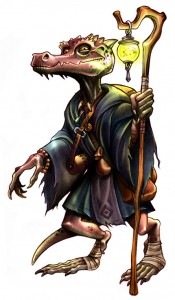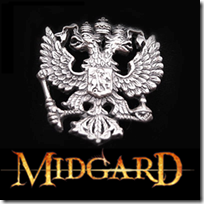 Recently I have posted about Open Design’s latest patronage project: Midgard! And while pondering if I should become patron myself, the plan to do an interview with the three designers formed in my head. Alas Brandon Hodge and Jeff Grubb couldn’t make it because of some difficult deadlines, but Wolfgang Baur made some time for answering a few questions for us. Thanks again, Wolfgang! I also want to send my best regards to Jeff and Brandon – rest assured you won’t escape me next time! 😉
Recently I have posted about Open Design’s latest patronage project: Midgard! And while pondering if I should become patron myself, the plan to do an interview with the three designers formed in my head. Alas Brandon Hodge and Jeff Grubb couldn’t make it because of some difficult deadlines, but Wolfgang Baur made some time for answering a few questions for us. Thanks again, Wolfgang! I also want to send my best regards to Jeff and Brandon – rest assured you won’t escape me next time! 😉
Without further ado, here are the questions and answers:
Stargazer’s World:
Thanks again for answering a couple of questions for us. Although I think most of our readers already know you and some of your products, but perhaps you could start by telling a bit about yourself. What do you do when you don’t design worlds? How long have you been working in the RPG industry?
Wolfgang Baur:
I spend my RPG time working at a game company on video games. I worked full-time in the RPG industry from 1991 to 1998; since then, I’ve been a freelancer and a publisher.
Stargazer’s World:
What was the first RPG you ever played?
Wolfgang Baur:
The first RPG I ever played was Dungeons & Dragons. I have played a lot of Call of Cthulhu, Alternity, and a bit of Pendragon since then, but mostly I prefer straight-up fantasy.
Stargazer’s World:
Recently you started Midgard as an Open Design patronage project. Can you please explain what’s Open Design and how patronage works?
Wolfgang Baur:
 Sure, Open Design is my publishing company, and it publishes Kobold Quarterly magazine plus adventures and sourcebooks. It was founded in 2006 and re-instituted the patronage system, which was popular in earlier times, before the rise of joint stock companies and the like.
Sure, Open Design is my publishing company, and it publishes Kobold Quarterly magazine plus adventures and sourcebooks. It was founded in 2006 and re-instituted the patronage system, which was popular in earlier times, before the rise of joint stock companies and the like.
Patronage is a way for gamers to participate in designing adventures and supplements, by both funding the work and by critiquing, brainstorming, and improving the design as it goes along. It’s collaborative design, guided by an experienced designer who has the professional chops to keep the project on course. In the case of the Midgard campaign setting, those professionals are me, Jeff Grubb of Dragonlance, Guild Wars, and Forgotten Realms fame, and rising RPG star Brandon Hodge.
Stargazer’s World:
How much influence into the design process do the patrons have?
Wolfgang Baur:
The degree of influence patrons have depends on interest and ability as much as anything.
Patrons who comment, test, and contribute can wind up writing a section of a book, and they are paid and credited as designers for the projects. Others patrons playtest, or throw out ideas for others to develop.
It’s really up to the particular gamer; some lurk and are just happy to see the quality of the resulting books. Others are deeply involved in pitching adventures, monsters, and sections of a book.
Stargazer’s World:
Using the patron model forces you to write the material for the system voted for by the patrons. What system do you prefer to use when you GM or play in a game, since this was your home setting to begin with?
Wolfgang Baur:
I have run the Midgard campaign setting using 3E D&D, 4E D&D, Pathfinder RPG, and Dragon Age RPG. They all have their advantages, frankly, and I’m not a believer in the One True System for RPGs. I’ve probably run Midgard for 4E more often than other systems, but that’s likely to change.
The question sort of misses the point of a multi-system setting, though. The Midgard campaign setting focuses on player action and changing the world, with options for conflict and adventure in any system. So far, mechanics have been secondary to world development. I’m pleased that the setting doesn’t require a particular rule set, though of course the play experience is slightly different with each system.
Or put another way, I’ve run Forgotten Realms in 4 editions. I’m sure Midgard will work in just as many.
Stargazer’s World:
Can you give us a short introduction into the world of Midgard? What sets Midgard apart from other fantasy settings? What players will it appeal to?
Wolfgang Baur:
It’s built on Germanic and Slavic foundations, rather than the usual pseudo-Celtic and British mythology, so it’s perhaps a little darker than some.
Midgard’s pseudo-medieval societies are definitely warped by magic and non-human races—it will appeal to anyone who thinks that a Sultan of the Dragon Empire is a fine villain, anyone who wants to sail with the minotaur corsairs or fight against gnomes who serve the Dukes of Hell. Baba Yaga plots and schemes, vampiric princes rule sections of the world, and steppe centaurs serve tsars and slaver despots. It’s a nasty place, a lot of the time, with large stretches of wilderness, forests where no one rules, land no one claims.
At the same time, players who enjoy history will see echoes of that: a ruling house with a lot of scattered holdings, an electoral kingdom of hussars and nobles, an oracle who has grown enormously wealthy. But these elements are all done with a twist, just as Planescape was done with a twist: Midgard sea-reavers are dwarves, Midgard’s tsars are pawns of greater evils, Midgard’s rivers really are haunted by the lorelei. Players have a ton of places to explore and treasures to recover.
Midgard appeals to traditional fantasy gamers who don’t want another kitchen sink campaign, and who enjoy a little more depth in their setting. The design goal is to focus on what players do in the here and now, not long-winded backstory!
Stargazer’s World:
What role will each of the three designers fill during the design phases of Midgard?
Wolfgang Baur:
The project is divided by regions. Jeff Grubb will be leading on one of the 7 regions, Brandon one or two more, I’ll take two—and the remainder are for patrons to design together with a lead designer, if they so choose. Which region will we do first? That’s up to the patrons!
The choices include the Dragon Empire, the Domains of the Princes, a wilderness region with Mythos influences, the Zobeck Crossroads, the Steppes, Trollheim, and the warring states of the Seven Cities region.
Some of those are almost entirely blank slates for patrons and designers to create. Others (like Zobeck) have a lot of lore and prior adventure for us to streamline into a campaign setting summary.
Stargazer’s World:
How do you plan on incorporating, or not incorporting, material like Courts of the Shadowfey, Sunken Empires, etc. into the lore and presentation of the world of Midgard in the campaign setting itself?
Wolfgang Baur:
Courts and Sunken Empires and the other adventures and supplements are all part of the setting. I’d go so far as to say they’re the reason I’m doing the setting; gamers have asked for the setting to be knit together from the many hints and setting elements found in the books so far.
Stargazer’s World:
Midgard is your largest Open Design Project so far. Will you be working on smaller projects until its release, too, or will you focus exclusively on Midgard?
Wolfgang Baur:
I won’t be working on anything but this. Other experienced designers are working on other Open Design projects, and some of those will ship in spring and summer of this year: Logan Bonner’s Lost City for 4th Edition D&D, Ben McFarland’s Streets of Zobeck noir adventures for Pathfinder RPG, and the Northlands sourcebook by Dan Voyce, to name just three.
Stargazer’s World:
Do you plan to support Midgard with adventures, regional sourcebooks, etc. after its release?
Wolfgang Baur:
Absolutely! The patrons have already made two suggestions that seem like good expansions of the core setting: an intro adventure and an adventure collection are a certainty. The first of those may be announced this summer. We’ll also release the first completed region of Midgard this summer!
Stargazer’s World:
Thanks again for taking your time for this interview. The team of Stargazer’s World wish you good luck with Midgard and all your other projects! And please send our best wishes to Jeff and Brandon!
By the way, if you got interested in becoming a patron of the Midgard Campaign Setting, check out this Kobold Quarterly store page for details.

Great interview. Glad to hear that the adventures out there are at the core of this upcoming setting. I look forward to seeing how it turns out in the end. Hopefully it will get some 4e love. Also, more roaches are always welcome.
I was thinking of being a Patron but with work and trying to write my own world I don't think I could give it the time it really deserves.